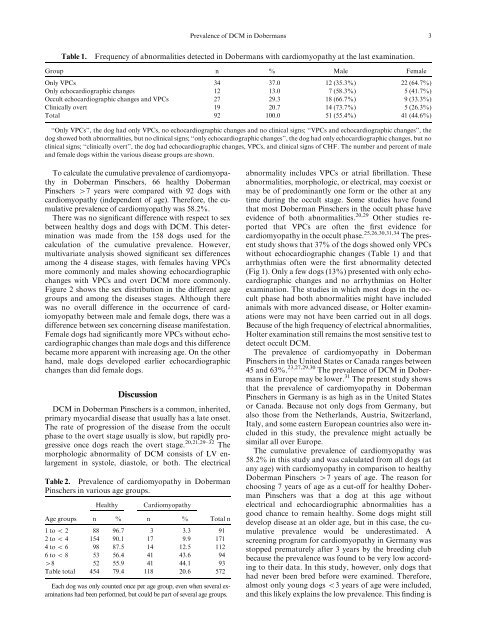Prevalence of Dilated Cardiomyopathy in Doberman Pinschers in ...
Prevalence of Dilated Cardiomyopathy in Doberman Pinschers in ...
Prevalence of Dilated Cardiomyopathy in Doberman Pinschers in ...
Create successful ePaper yourself
Turn your PDF publications into a flip-book with our unique Google optimized e-Paper software.
<strong>Prevalence</strong> <strong>of</strong> DCM <strong>in</strong> <strong>Doberman</strong>s<br />
3<br />
Table 1.<br />
Frequency <strong>of</strong> abnormalities detected <strong>in</strong> <strong>Doberman</strong>s with cardiomyopathy at the last exam<strong>in</strong>ation.<br />
Group n % Male Female<br />
Only VPCs 34 37.0 12 (35.3%) 22 (64.7%)<br />
Only echocardiographic changes 12 13.0 7 (58.3%) 5 (41.7%)<br />
Occult echocardiographic changes and VPCs 27 29.3 18 (66.7%) 9 (33.3%)<br />
Cl<strong>in</strong>ically overt 19 20.7 14 (73.7%) 5 (26.3%)<br />
Total 92 100.0 51 (55.4%) 41 (44.6%)<br />
‘‘Only VPCs’’, the dog had only VPCs, no echocardiographic changes and no cl<strong>in</strong>ical signs; ‘‘VPCs and echocardiographic changes’’, the<br />
dog showed both abnormalities, but no cl<strong>in</strong>ical signs; ‘‘only echocardiographic changes’’, the dog had only echocardiographic changes, but no<br />
cl<strong>in</strong>ical signs; ‘‘cl<strong>in</strong>ically overt’’, the dog had echocardiographic changes, VPCs, and cl<strong>in</strong>ical signs <strong>of</strong> CHF. The number and percent <strong>of</strong> male<br />
and female dogs with<strong>in</strong> the various disease groups are shown.<br />
To calculate the cumulative prevalence <strong>of</strong> cardiomyopathy<br />
<strong>in</strong> <strong>Doberman</strong> P<strong>in</strong>schers, 66 healthy <strong>Doberman</strong><br />
P<strong>in</strong>schers 47 years were compared with 92 dogs with<br />
cardiomyopathy (<strong>in</strong>dependent <strong>of</strong> age). Therefore, the cumulative<br />
prevalence <strong>of</strong> cardiomyopathy was 58.2%.<br />
There was no significant difference with respect to sex<br />
between healthy dogs and dogs with DCM. This determ<strong>in</strong>ation<br />
was made from the 158 dogs used for the<br />
calculation <strong>of</strong> the cumulative prevalence. However,<br />
multivariate analysis showed significant sex differences<br />
among the 4 disease stages, with females hav<strong>in</strong>g VPCs<br />
more commonly and males show<strong>in</strong>g echocardiographic<br />
changes with VPCs and overt DCM more commonly.<br />
Figure 2 shows the sex distribution <strong>in</strong> the different age<br />
groups and among the diseases stages. Although there<br />
was no overall difference <strong>in</strong> the occurrence <strong>of</strong> cardiomyopathy<br />
between male and female dogs, there was a<br />
difference between sex concern<strong>in</strong>g disease manifestation.<br />
Female dogs had significantly more VPCs without echocardiographic<br />
changes than male dogs and this difference<br />
became more apparent with <strong>in</strong>creas<strong>in</strong>g age. On the other<br />
hand, male dogs developed earlier echocardiographic<br />
changes than did female dogs.<br />
Discussion<br />
DCM <strong>in</strong> <strong>Doberman</strong> P<strong>in</strong>schers is a common, <strong>in</strong>herited,<br />
primary myocardial disease that usually has a late onset.<br />
The rate <strong>of</strong> progression <strong>of</strong> the disease from the occult<br />
phase to the overt stage usually is slow, but rapidly progressive<br />
once dogs reach the overt stage. 20,21,29–32 The<br />
morphologic abnormality <strong>of</strong> DCM consists <strong>of</strong> LV enlargement<br />
<strong>in</strong> systole, diastole, or both. The electrical<br />
Table 2. <strong>Prevalence</strong> <strong>of</strong> cardiomyopathy <strong>in</strong> <strong>Doberman</strong><br />
P<strong>in</strong>schers <strong>in</strong> various age groups.<br />
Healthy<br />
<strong>Cardiomyopathy</strong><br />
Age groups n % n % Total n<br />
1too 2 88 96.7 3 3.3 91<br />
2too 4 154 90.1 17 9.9 171<br />
4too 6 98 87.5 14 12.5 112<br />
6too 8 53 56.4 41 43.6 94<br />
48 52 55.9 41 44.1 93<br />
Table total 454 79.4 118 20.6 572<br />
Each dog was only counted once per age group, even when several exam<strong>in</strong>ations<br />
had been performed, but could be part <strong>of</strong> several age groups.<br />
abnormality <strong>in</strong>cludes VPCs or atrial fibrillation. These<br />
abnormalities, morphologic, or electrical, may coexist or<br />
may be <strong>of</strong> predom<strong>in</strong>antly one form or the other at any<br />
time dur<strong>in</strong>g the occult stage. Some studies have found<br />
that most <strong>Doberman</strong> P<strong>in</strong>schers <strong>in</strong> the occult phase have<br />
evidence <strong>of</strong> both abnormalities. 20,29 Other studies reported<br />
that VPCs are <strong>of</strong>ten the first evidence for<br />
cardiomyopathy <strong>in</strong> the occult phase. 25,26,30,31,34 The present<br />
study shows that 37% <strong>of</strong> the dogs showed only VPCs<br />
without echocardiographic changes (Table 1) and that<br />
arrhythmias <strong>of</strong>ten were the first abnormality detected<br />
(Fig 1). Only a few dogs (13%) presented with only echocardiographic<br />
changes and no arrhythmias on Holter<br />
exam<strong>in</strong>ation. The studies <strong>in</strong> which most dogs <strong>in</strong> the occult<br />
phase had both abnormalities might have <strong>in</strong>cluded<br />
animals with more advanced disease, or Holter exam<strong>in</strong>ations<br />
were may not have been carried out <strong>in</strong> all dogs.<br />
Because <strong>of</strong> the high frequency <strong>of</strong> electrical abnormalities,<br />
Holter exam<strong>in</strong>ation still rema<strong>in</strong>s the most sensitive test to<br />
detect occult DCM.<br />
The prevalence <strong>of</strong> cardiomyopathy <strong>in</strong> <strong>Doberman</strong><br />
P<strong>in</strong>schers <strong>in</strong> the United States or Canada ranges between<br />
45 and 63%. 23,27,29,30 The prevalence <strong>of</strong> DCM <strong>in</strong> <strong>Doberman</strong>s<br />
<strong>in</strong> Europe may be lower. 31 The present study shows<br />
that the prevalence <strong>of</strong> cardiomyopathy <strong>in</strong> <strong>Doberman</strong><br />
P<strong>in</strong>schers <strong>in</strong> Germany is as high as <strong>in</strong> the United States<br />
or Canada. Because not only dogs from Germany, but<br />
also those from the Netherlands, Austria, Switzerland,<br />
Italy, and some eastern European countries also were <strong>in</strong>cluded<br />
<strong>in</strong> this study, the prevalence might actually be<br />
similar all over Europe.<br />
The cumulative prevalence <strong>of</strong> cardiomyopathy was<br />
58.2% <strong>in</strong> this study and was calculated from all dogs (at<br />
any age) with cardiomyopathy <strong>in</strong> comparison to healthy<br />
<strong>Doberman</strong> P<strong>in</strong>schers 47 years <strong>of</strong> age. The reason for<br />
choos<strong>in</strong>g 7 years <strong>of</strong> age as a cut-<strong>of</strong>f for healthy <strong>Doberman</strong><br />
P<strong>in</strong>schers was that a dog at this age without<br />
electrical and echocardiographic abnormalities has a<br />
good chance to rema<strong>in</strong> healthy. Some dogs might still<br />
develop disease at an older age, but <strong>in</strong> this case, the cumulative<br />
prevalence would be underestimated. A<br />
screen<strong>in</strong>g program for cardiomyopathy <strong>in</strong> Germany was<br />
stopped prematurely after 3 years by the breed<strong>in</strong>g club<br />
because the prevalence was found to be very low accord<strong>in</strong>g<br />
to their data. In this study, however, only dogs that<br />
had never been bred before were exam<strong>in</strong>ed. Therefore,<br />
almost only young dogs o3 years <strong>of</strong> age were <strong>in</strong>cluded,<br />
and this likely expla<strong>in</strong>s the low prevalence. This f<strong>in</strong>d<strong>in</strong>g is






